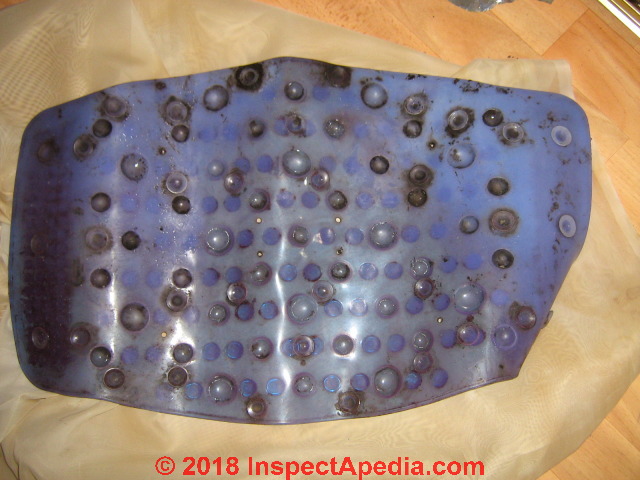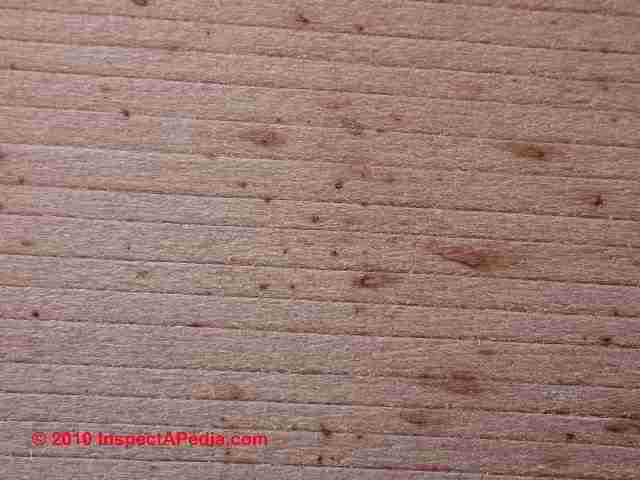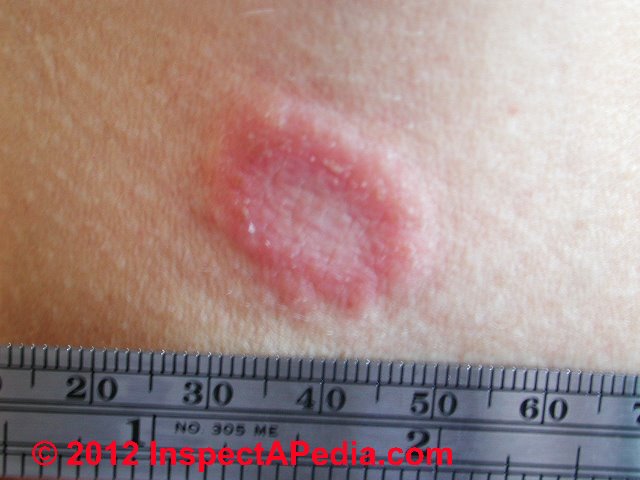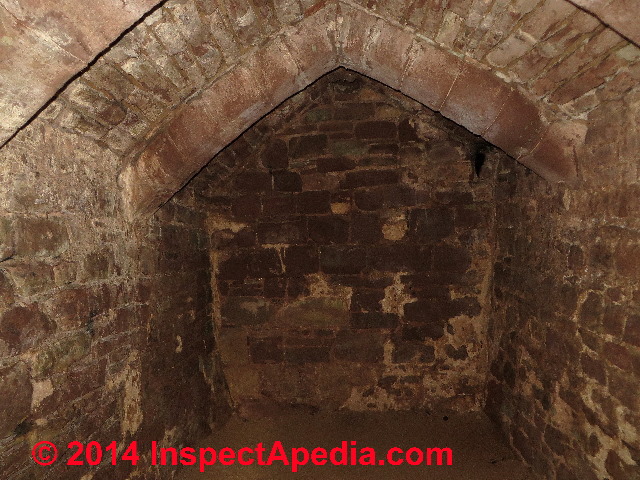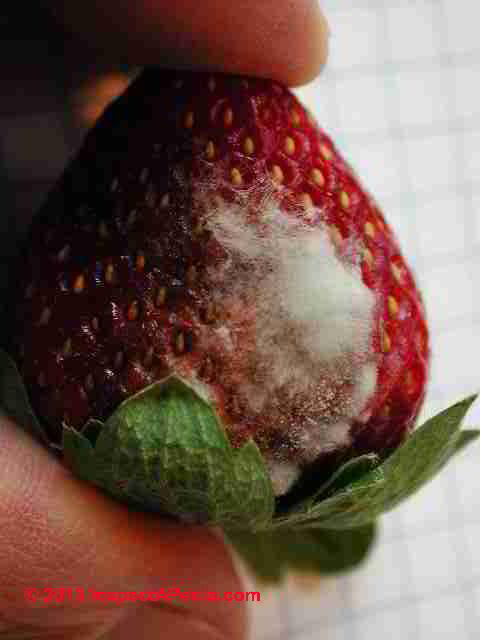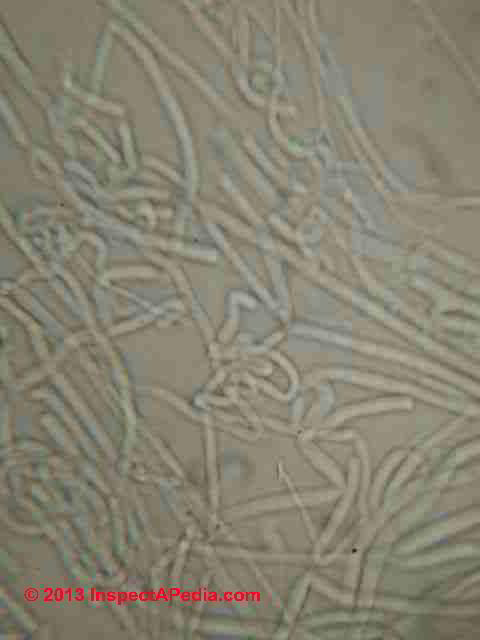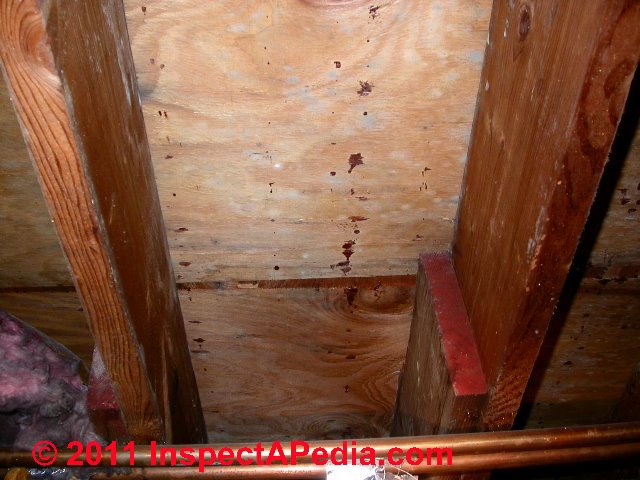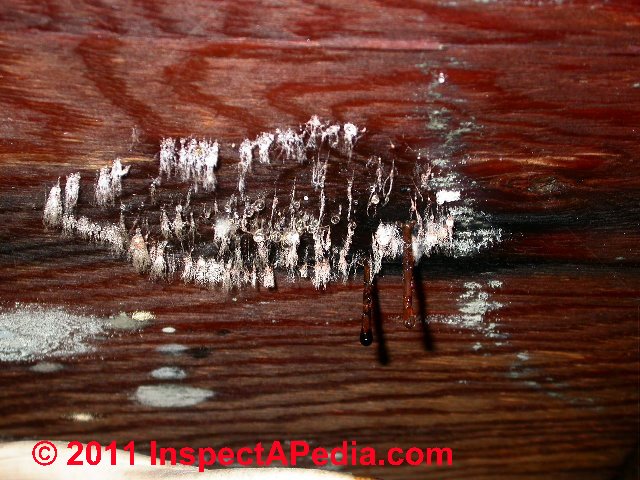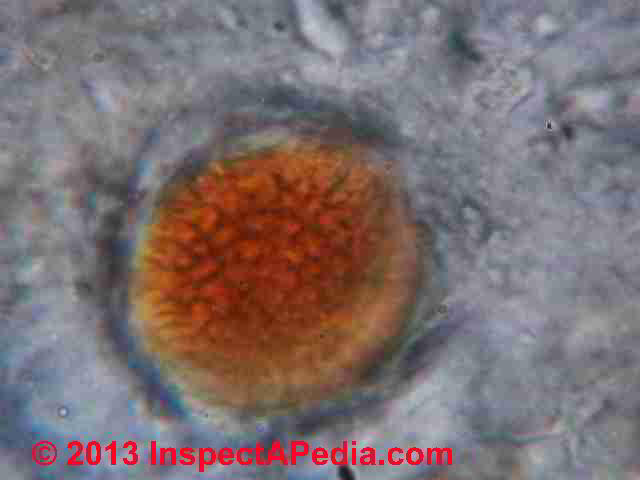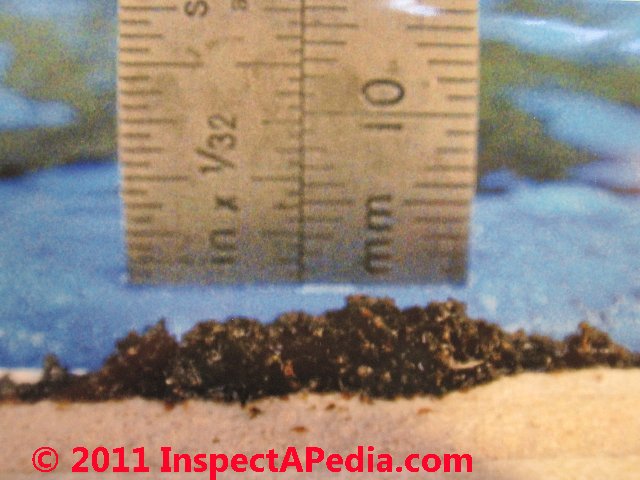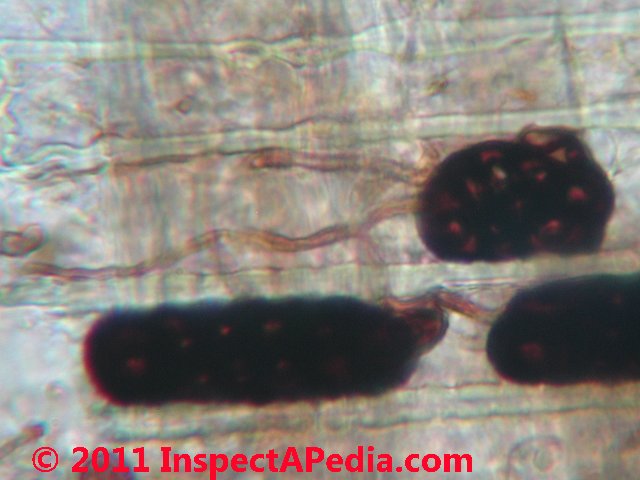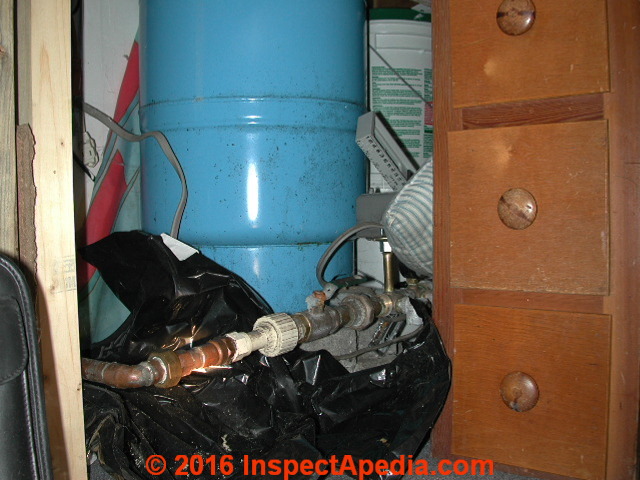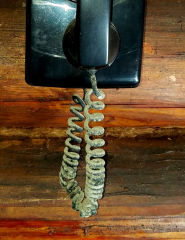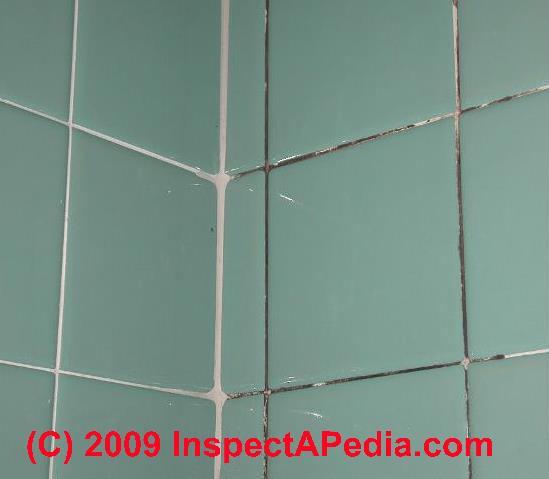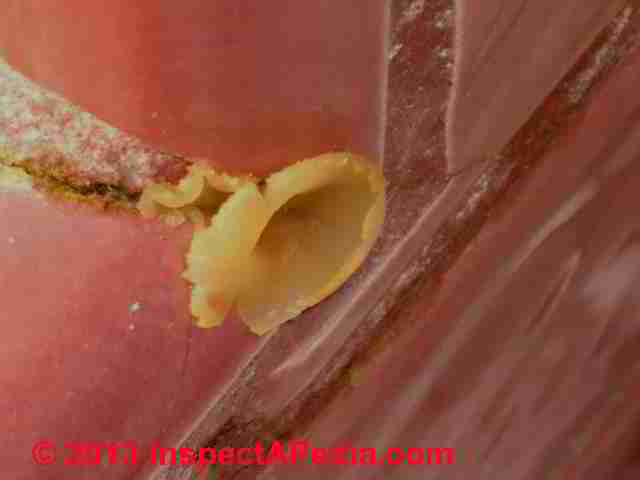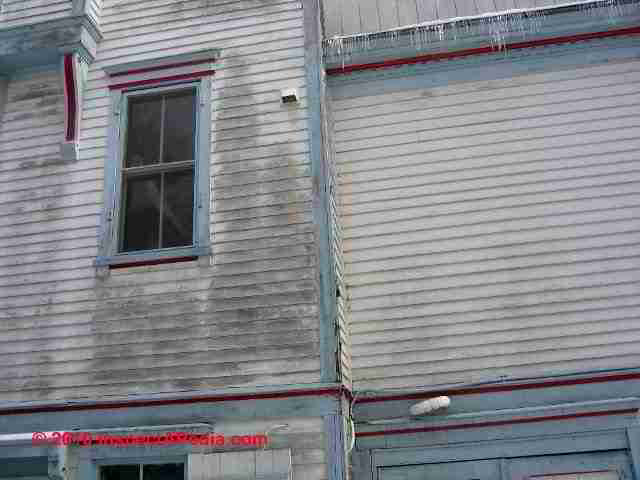 Mold In-Situ: Photos of Mold on Surfaces - Group 9
Mold In-Situ: Photos of Mold on Surfaces - Group 9
Appearance of Mold on Different Materials & Surfaces.
- POST a QUESTION or COMMENT about what mold looks like in buildings, including mobile homes and trailers
Photographs of mold growth in buildings:
Here is a photo guide to mold on shoes, mold on vinyl siding, mold on wood siding, mold on stereo systems, mold on stone surfaces, mold on strawberries, mold on subflooring, mold on swimming pools, mold on pool liners, mold on tile, mold on ceramic tile, mold on roof tiles, mold on roof shingles.
What does mold look like growing on various building & other material surfaces? Here is an online reference photo library of various kinds of mold as it is found growing on a wide range of surfaces and materials found on or in buildings. These photos of mold on indoor various materials or "mold growth substrates" may help you recognize mold in buildings, recognize probably-cosmetic mold, and recognize stuff that is not mold and does not need to be tested.
InspectAPedia tolerates no conflicts of interest. We have no relationship with advertisers, products, or services discussed at this website.
- Daniel Friedman, Publisher/Editor/Author - See WHO ARE WE?
Pictures of Mold on Various Building Surfaces and Materials
Use the link
MOLD APPEARANCE on VARIOUS SURFACES - INDEX
to return to the index / list of photographs of the appearance of mold on various building materials & contents.
--- MOLD GROWTH on MATERIAL SURFACES PHOTOS GROUP 9 ---
- MOLD on SHOES
- MOLD on SHOWER MATS
- MOLD on SIDING, Vinyl
- MOLD on SIDING, Wood
- MOLD on SKIN, human/animal
- MOLD on SOIL - see MOLD on DIRT SURFACES
- MOLD on STEREO SYSTEMS, Speakers
- MOLD on STONE SURFACES, outdoors
- MOLD on STRAWBERRIES stored on a kitchen counter
- MOLD on SUBFLOORING
- MOLD on SWIMMING POOLS, Liners, Tiles
- MOLD on TANKS, WATER, OTHER
- MOLD on TELEPHONE CORDS
- MOLD on TILE, CERAMIC
- MOLD on TILES, ROOF
Photographs of mould found on the surface of items, materials, & surfaces found indoors
[Click to enlarge any image]
Mold on Shoes

This photograph illustrates mold growth on shoes.
It is interesting to speculate about why mold grew heavily on those black leather shoes in the center of this picture. Certainly we also find mold on canvas and even plastic, including shoes.
Perhaps factors that determined this particular mold observation include:
- How long different shoes had been in the wet environment
- The shoe material, even species of leather
- Shoe polish
- Previous exposure of the shoes to other contaminants - worn in a wet barn for example
Shower Mat Mold
Above: black and brown mold growing on a (probably vinyl) shower mat.
Watch out: don't miss the irony that a shower mat, intended to prevent a bad slip and fall in the tub or shower by providing improved traction on the walking surface, itself becomes a seriously slippery surface if the shower mat becomes covered in mold growth and algae growth - both of which may be present in this case.
Mold on Siding, Vinyl
Below at left we show what is either a black algae on vinyl siding, a dark mold, or both; and at belwo right we illustrate mold growth on vinyl siding, possibly an "artillery fungus".
A pen cap is included in the right-hand photo for scale. Artillery fungus can produce black specs on a building wall, trim, or other outdoor surfaces. Similar black specs may be found on exterior siding where the attachment points of vines have adhered to the surface.
On vinyl siding as well as on some roof surfaces, a lab examination of a tape sample may be necessary to distinguish between a black, brown, green or red algae or a fungus (mold) growth.
Details are at VINYL SIDING STAINS
and at ALGAE, FUNGUS, LICHENS, MOSS
Mold on Wood Siding: claboards or wood shingles (also wood shingle roofs)
Below we illustrate (as we did at MOLD on SIDING, Vinyl), stains on building siding that may be either algae or mold. Often we can make a definitive distinction between algae and mold on wood siding by the growth pattern in the stain, since fungal growth often has a distinctive pattern.
But both algae and mold growth on wood surfaces will often follow a water, wetting, or drainage pattern as you can see in our photo at below left.
These stains on wood siding were identified as a fungal growth.
Below: fungal growth, the fruiting body of some molds, shown as an extensive growth on a wood shingled exterior wall.
These fungal-contaminated wood shingles are discussed in detail
at MOLD & FUNGUS on WOOD SIDING: CLEAN & PREVENT
Mold on Skin, Human / Animal
OK so except on a cadaver of a human or animal you should only rarely find visible mold on skin surfaces except for incidental fungal spores settling out of air or dust.
We have collected tape samples of areas of skin irritation for which the client was confident that there was an airborne environmental cause such as fibers, fiberglass, or mold. See MORGELLONS SYNDROMEfor notes about cases in which the skin particles, under the microscope, indicated something else.
Watch out: after working in a mold-contaminated building I tested myself for surface mold contamination using vacuum-sampling cassettes and a portable vacuum pump. Wearing protective clothing, a mask, even gloves, but no hat? Expect to find a heck of a lot of moldy dust in your hair and on the back of your sweaty neck.
Above: close-up photo of a skin rash on one of my clients; this rash was attributed to exposure of high levels of Stachybotrys chartarum during a DIY mold cleanup job. More about this case and similar ones is at MOLD RELATED ILLNESS FAQs
See MOLD RELATED ILLNESS SYMPTOMS
Also see ALLERGY TESTS for PEOPLE for warnings about the limitations of allergy testing
Also see MVOCs & MOLDY MUSTY ODORS
Mold on Stereo Systems, Speakers

This photograph illustrates mold growth on the cloth facing of a stereo speaker. You might also find mold growth on the paper speaker cone, the interior of a speaker cabinet and of course its exterior.
Mold growth may also attack electrical components in stereo equipment.
Mold on Stone or Masonry Building Exteriors & Stone Artifacts & Statues
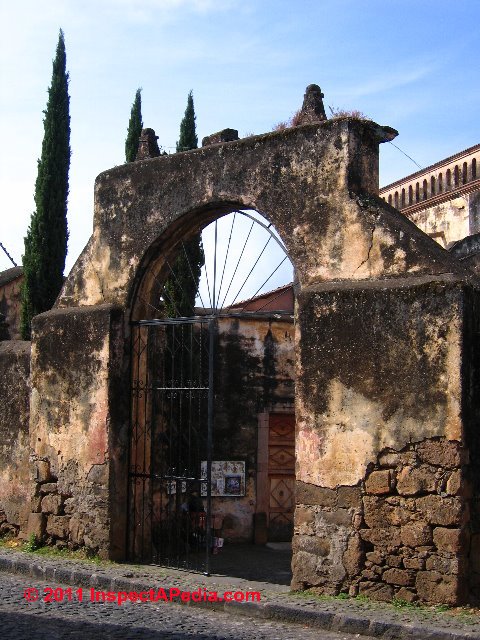
This photograph at above left illustrates mold or algal growth on a stone and masonry exterior - in this example, the gate to Templo del Sagrario in Patzcuaro, Mexico.
Below are black and brown stains on brick and stone of the dungeon at Goodrich Castle, Ross on Wye, in England.
Without microscopic analysis it is difficult to distinguish between algae on building exteriors and mold growth that sometimes also occurs in those locations.
See STAINS on BRICK SURFACES for details about cleaning moldy surfaces from brick.
See STONE, STUCCO & BRICK CLEANING METHODS for procedures for cleaning algae, lichens, mold and moss from stone surfaces.
See ART CONSERVATION - Cultural Heritage and Aerobiology [book review] for a useful text on this topic.
Mold on Strawberries
Photographs: typical mold growth on fresh strawberries. At above right is the dominant fungal material, hyaline fungal hyphae.
Also see Mycotoxicosis at MOLD EXPOSURE, FOOD HAZARDS.
Mold on Subflooring in buildings
Mold on plywood subflooring can be difficult to spot if the mold contamination is not extensive, but the green mold visible in our right hand photo of the same subfloor is a warning of wet or damp mold-conducive conditions in this area.
Watch out: finding this mold sign is a reminder that the rest of the structure needs careful inspection as there may be a larger problem elsewhere.
Black mold on rotting plywood subfloor belowat left was found in a crawl area below a leaky sliding glass door - this "black mold" was Taeoniella
rudus for which no medical issues have been reported - a wood rotting organism though.
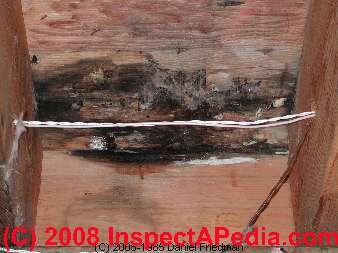
Below we see multiple mold genera/spcies on both floor joists and subflooring over a wet basement of a New York Home. Some of these fungal growths are quite possibly harmful to building occupants.
An investigation of the source of outside leaks and extent of damage to the structure were needed at these buildings.
At below left our photograph illustrates mold growth in a pattern and locations common on the subfloor over a damp or wet basement or crawl space. At below right the fungal growth on this wet subfloor confirms an extended period of very wet conditions.
Also see MOLD on OSB SHEATHING BOARD
The interesting pattern below appears in a fern-like pattern on the under-side of plywood subfloor over a wet basement.
With reader help we figured that these marks are probably the imprint of the wax honeybee combs from a feral honey bee infestation.
Details are at MOLD APPEARANCE - STUFF THAT IS NOT MOLD
We had only some wood chips to work with, but were able to isolate the fungal spores below. At above right we see what looks like a basidiomycete colony - a wood rotting fungus along the side of a floor joist.
The case history and more information about this subfloor mold appear
at MOLD APPEARANCE - STUFF THAT IS NOT MOLD.
We welcome comments (CONTACT) from others about the identification of this fungus
Mold on Swimming Pools, Liners, Tiles
The photo below was sent by a client who was investigating suspected-mold growth at the edge of a swimming pool liner and coping.
We suspected and lab tests confirmed that this was an insect material not a fungus.
Our second photograph, below, illustrates a common mold that was found by our lab test of deposits on a swimming pool surround.
Mold on Tanks, Metal, Painted Water Tanks & Other Tanks
Above: dark coloured mold on the painted surface of two water pressure tanks in two different homes. Click to enlarge the first photo and you may also notice mold visible on the white plastic plumbing fittings.
Watch out: Except for doing something stupid like rubbing your fingers in mold and then rubbing them in your eye or on an open cut, there's virtually no chance that mold on a water pressure tank is going to be enough in total area or volume to be a serious indoor health hazard.
However wet conditions from high volumes of condensate on the water tank exterior or from building leaks may wet other building materials around the water tank and that could lead to trouble with indoor mold.
In our first photo above, I see a pillow, wood furniture, drywall, and other materials jammed around the water pressure tank and all forming possible additional mold reservoirs.
See CONDENSATION or SWEATING PIPES, TANKS
Mold on Telephone Cords
Below we show thick green and white mold on a telephone handset cord observed in 2020 on a dial-telephone installed in a 1935 log cabin at Elk Lake Michigan.
Mold & Mushrooms Growing on Tile, Ceramic
Our photographs below show mold on ceramic tile grout joints. We may also find mold growth on actual ceramic tile surfaces - we believe that in that case mold is hosted on a film of organic material such as soap.
The fungus we identify on bath tile and tile grout is often a Cladosporium species.
But if you see actual mushrooms growing out of the ceramic tile wall you should figure that there has been more hidden leakage and there may be more rot and damage than meets the eye.
See BATHROOM MOLD for more detail about mold on bathroom surfaces including tile and tile grout.
Also see MOLD on BATHROOM SURFACES
Mold on Tile, Roof
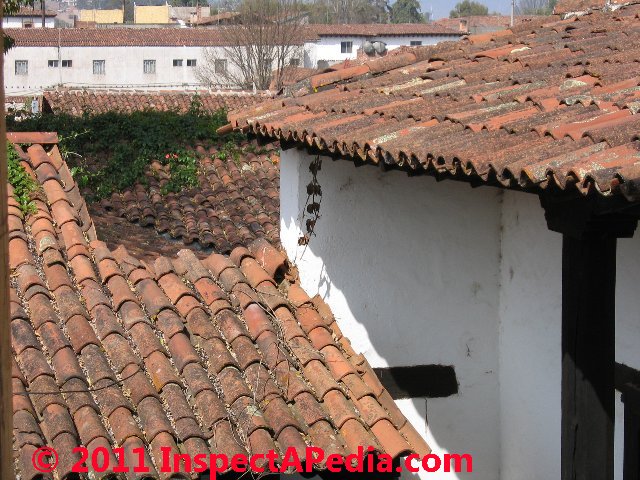
This photograph illustrates mold growth or possibly algae growth on clay roofing tiles.
Mold may also form (usually as a stain) on other roofing surfaces such as asphalt shingles or painted metal roofing. However algae is a more common roof stainer that may be mistaken for mold growth. While we have not confirmed its presence, some black stains
on roofs and roof gutters might be due to black molds or sooty molds, for which the USDA has published
HOW TO RECOGNIZE & CONTROL SOOTY MOLDS [PDF]
See STAIN DIAGNOSIS on ROOFS for technical details about the various sources of stains or discoloration on building roofs.
CONTACT us to submit photographs of mold growth on other man-made or building-related materials.
...
Continue reading at MOLD GROWTH on SURFACES, PHOTOS_GROUP_10 or select a topic from the closely-related articles below, or see the complete ARTICLE INDEX.
Or see these
Mold Identification Articles
- BLACK MOLD, HARMLESS
- MOLD APPEARANCE on VARIOUS SURFACES index to photos of mold on all kinds of surfaces and materials
- MOLD APPEARANCE - WHAT MOLD LOOKS LIKE - home
- MOLD APPEARANCE - STUFF THAT IS NOT MOLD
- MOLD ATLAS & PARTICLES INDEX
- MOLD FREQUENCY in BUILDINGS
- MOLD in BUILDINGS
- MOLD CONTAMINATION IN BUILDINGS - home
- MOLD by MICROSCOPE - mold under the microscope
- MOLD in the PETRI DISH, PHOTOS - mold on culture plates or in culture-type mold test kits
- MOLD RELATED ILLNESS SYMPTOMS
s.
Suggested citation for this web page
MOLD GROWTH on SURFACES, PHOTOS_GROUP_9 at InspectApedia.com - online encyclopedia of building & environmental inspection, testing, diagnosis, repair, & problem prevention advice.
Or see this
INDEX to RELATED ARTICLES: ARTICLE INDEX to MOLD CONTAMINATION & REMEDIATION
Or use the SEARCH BOX found below to Ask a Question or Search InspectApedia
Ask a Question or Search InspectApedia
Try the search box just below, or if you prefer, post a question or comment in the Comments box below and we will respond promptly.
Search the InspectApedia website
Note: appearance of your Comment below may be delayed: if your comment contains an image, photograph, web link, or text that looks to the software as if it might be a web link, your posting will appear after it has been approved by a moderator. Apologies for the delay.
Only one image can be added per comment but you can post as many comments, and therefore images, as you like.
You will not receive a notification when a response to your question has been posted.
Please bookmark this page to make it easy for you to check back for our response.
IF above you see "Comment Form is loading comments..." then COMMENT BOX - countable.ca / bawkbox.com IS NOT WORKING.
In any case you are welcome to send an email directly to us at InspectApedia.com at editor@inspectApedia.com
We'll reply to you directly. Please help us help you by noting, in your email, the URL of the InspectApedia page where you wanted to comment.
Citations & References
In addition to any citations in the article above, a full list is available on request.
- [2] Dictionary of the Fungi, 9th Ed., PM Kirk, PF Cannon, JC David, && JA Stalpers Ed., CABI Publishing 2001 ISBN 0 85199 377 X www.cabi.org UK
- [3] Fifth Kingdom, The, 2nd ed., Bryce Kendrick, Mycologue Publications 1992, ISBN 0-941051-28-5
- [4] Fungi From Utility Poles in the Eastern United States, Identification Manual for, CJK Wang & RA Zabel Ed., Allen Press, 1990, ISBN 0-93-0009-31-2
- [5] Fungi, Identifying Filamentous, A Clinical Laboratory Handbook, Guy St-Germain, Richard Summerbell, Star Publishing, 1996, ISBN 0-89863-177-7 (English)
- [6] Pictorial Atlas of Soil and Seed Fungi, , 2nd Ed., Tsuneo Watanabe, 2002 CRC Press, ISBN 0-8493-1118-7
- [8] Fusarium, Paul E. Nelson Memorial Symposium, Summerall et als. Ed., APS Press 2001, ISBN 0-89054-268-6
- [9] Hyphomycetes their perfect and imperfect connexions, K. Tubaki, J Cramer 1981, ISBN 3-7682-1267-X
- [10] Dematiaceous Hyphomycetes, , M.B. Ellis, CAB International 1971, ISBN 0-85198-027-8, Commonwealth Mycological Institute, Kew, Surrey, England, ABE-Print.com
- [11] More Dematiaceous Hyphomycetes, M.B. Ellis, CAB International 1976, ISBN 0-85198-3650-, Commonwealth Mycological Institute, Kew, w:st="on">Surrey, England
- [12] Illustrated Genera of Imperfect Fungi, 4th Ed., HL Barnett & Barry B. Hunter, American Phytopathological Society Press, St. Paul, 1998, ISBN 0-89054-192-2
- In addition to citations & references found in this article, see the research citations given at the end of the related articles found at our suggested
CONTINUE READING or RECOMMENDED ARTICLES.
- Carson, Dunlop & Associates Ltd., 120 Carlton Street Suite 407, Toronto ON M5A 4K2. Tel: (416) 964-9415 1-800-268-7070 Email: info@carsondunlop.com. Alan Carson is a past president of ASHI, the American Society of Home Inspectors.
Thanks to Alan Carson and Bob Dunlop, for permission for InspectAPedia to use text excerpts from The HOME REFERENCE BOOK - the Encyclopedia of Homes and to use illustrations from The ILLUSTRATED HOME .
Carson Dunlop Associates provides extensive home inspection education and report writing material. In gratitude we provide links to tsome Carson Dunlop Associates products and services.


